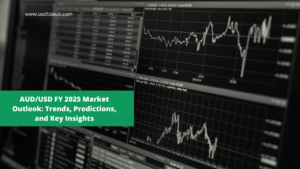The exchange rate between the Australian Dollar (AUD) and the United States Dollar (USD) is a key economic indicator that reflects the value of one currency relative to another.
It directly impacts trade, investment, tourism, and financial planning for individuals, businesses, and policymakers.
In this article, we explore what the AUD to USD exchange rate is, what factors influence it, historical trends, current data, and future projections. Additionally, we provide detailed tables for clarity and analysis.
AUD to USD Exchange Rate
The exchange rate tells us how much 1 Australian Dollar (AUD) is worth in United States Dollars (USD). For example:
- If the exchange rate is 1 AUD = 0.68 USD, it means 1 AUD can be exchanged for 68 US cents.
- Conversely, a stronger AUD might be worth 0.70 USD, while a weaker AUD might be valued at 0.65 USD.
The exchange rate between AUD and USD is dynamic, influenced by global financial markets and various economic factors.
Current AUD to USD Exchange Rate
As of mid-2024, the AUD to USD exchange rate is fluctuating between 0.65 and 0.68 USD per 1 AUD. The actual rate may vary slightly depending on the source, market conditions, and financial institutions.
Below is an approximate snapshot of recent exchange rates:
| Date | AUD to USD Exchange Rate |
|---|---|
| January 1, 2024 | 0.67 USD |
| February 1, 2024 | 0.66 USD |
| March 1, 2024 | 0.68 USD |
| April 1, 2024 | 0.65 USD |
| May 1, 2024 | 0.66 USD |
Exchange rates are subject to change due to economic events, monetary policies, and market sentiment.
What Influences the AUD to USD Exchange Rate?
Several factors contribute to the movements of the AUD to USD exchange rate:
1. Interest Rate Differentials
Interest rates set by the Reserve Bank of Australia (RBA) and the Federal Reserve (Fed) have a significant impact:
- Higher interest rates in Australia attract foreign investment, increasing demand for AUD.
- If the US raises interest rates faster than Australia, the USD strengthens against the AUD.
2. Commodity Prices
Australia is a major exporter of commodities such as iron ore, coal, and natural gas. Higher commodity prices benefit the AUD because:
- Export revenues increase, improving Australia’s trade balance.
- A decline in commodity prices weakens the AUD.
3. Economic Performance
Key economic indicators like GDP growth, employment rates, and inflation in Australia and the US impact exchange rates.
- Strong Australian economic data boosts the AUD.
- Weak data or economic uncertainty puts downward pressure on the AUD.
4. Global Risk Sentiment
The AUD is often referred to as a “risk-on currency” because it performs well when global markets are optimistic:
- During periods of global growth, investors seek higher returns and buy AUD.
- In times of uncertainty, investors flock to the USD as a safe-haven currency.
5. Trade Balance
Australia’s trade surplus or deficit affects demand for AUD:
- A trade surplus increases demand for AUD, strengthening the currency.
- A trade deficit weakens the AUD as importers sell AUD to buy foreign currencies.
6. US Dollar Strength
The USD’s strength on the global stage is another factor:
- When the USD appreciates due to higher interest rates or global demand, the AUD to USD rate declines.
- Conversely, a weaker USD allows the AUD to rise.
Historical Trends in AUD to USD Exchange Rate
The AUD to USD exchange rate has experienced significant fluctuations over the past two decades. Below is a table summarizing historical trends:
| Year | Average AUD to USD Exchange Rate | Key Events |
|---|---|---|
| 2001 | 0.50 USD | Strong USD, global slowdown |
| 2008 | 0.96 USD | Pre-Global Financial Crisis (GFC) boom |
| 2011 | 1.03 USD | Peak commodity prices, strong AUD |
| 2015 | 0.75 USD | Declining commodity demand |
| 2020 | 0.68 USD | COVID-19 economic disruption |
| 2023 | 0.67 USD | Fed interest rate hikes, strong USD |
Key Observations
- The AUD peaked above parity (1 AUD = 1.03 USD) in 2011 due to a global commodity boom.
- Post-2011, falling commodity prices and global economic uncertainty weakened the AUD.
- The COVID-19 pandemic caused sharp volatility, but the AUD stabilized around 0.68 USD.

Forecast for the AUD to USD Exchange Rate
Financial institutions and analysts provide forecasts based on current economic trends, interest rates, and global events. Below is a table summarizing key forecasts for 2024:
| Quarter | Forecast AUD to USD Exchange Rate | Key Drivers |
|---|---|---|
| Q1 2024 | 0.66 USD | Stable commodity prices, strong USD |
| Q2 2024 | 0.67 USD | Potential RBA rate hikes |
| Q3 2024 | 0.68 USD | Global risk-on sentiment improves |
| Q4 2024 | 0.70 USD | Recovery in global trade and exports |
Expert Opinions
- Commonwealth Bank predicts the AUD will reach 0.70 USD by late 2024, driven by strong commodity prices and stable economic growth.
- Westpac Bank expects the AUD to remain between 0.66 to 0.68 USD, depending on US interest rate decisions.
Impact of AUD to USD on the Economy
1. Trade and Exports
- A strong AUD makes Australian goods more expensive for foreign buyers, reducing export competitiveness.
- A weak AUD benefits Australian exporters by making their products cheaper in global markets.
2. Travel and Tourism
- For Australians traveling to the US, a stronger AUD reduces travel costs.
- A weaker AUD makes international travel more expensive for Australians but encourages US tourists to visit Australia.
3. Investment
- A strong AUD allows Australian investors to buy US assets at lower costs.
- Foreign investors find Australian markets more attractive when the AUD is weak.
4. Inflation and Import Costs
- A weak AUD increases the cost of importing goods, contributing to higher inflation.
- A strong AUD lowers import costs, helping to control inflation.
| Month | Forecast AUD to USD Rate | Key Economic Events |
|---|---|---|
| January 2024 | 0.66 USD | Fed interest rate decision |
| February 2024 | 0.67 USD | RBA monetary policy update |
| March 2024 | 0.68 USD | Commodity price recovery |
| April 2024 | 0.65 USD | Global economic slowdown |
| May 2024 | 0.66 USD | Improved trade balance for Australia |
How to Track the AUD to USD Exchange Rate
You can monitor the exchange rate through the following platforms:
- Bank Websites: Major banks like Commonwealth Bank and Westpac provide daily rates.
- Currency Exchange Apps: Apps like XE, Wise, and Revolut provide real-time updates.
- Financial News: Bloomberg, Reuters, and CNBC cover currency markets extensively.
- Central Bank Announcements: Updates from the RBA and Fed significantly impact exchange rates.
Strategies for Managing Exchange Rate Risks
If you are impacted by AUD to USD exchange rate fluctuations, consider the following strategies:
- Forward Contracts: Businesses can lock in exchange rates for future transactions to minimize risk.
- Currency Hedging: Use hedging instruments like options and futures to protect against unfavorable movements.
- Diversify Investments: Spread investments across multiple currencies to mitigate exchange rate exposure.
Conclusion
The AUD to USD exchange rate is a dynamic metric influenced by multiple factors, including interest rate differentials, commodity prices, economic performance, and global market sentiment.
As of 2024, the AUD is forecasted to trade between 0.65 and 0.70 USD, depending on economic developments in Australia and the US.
Understanding these trends and staying informed can help individuals, businesses, and investors make smarter financial decisions.
FAQs
1. What is the current AUD to USD exchange rate?
As of mid-2024, the AUD to USD exchange rate ranges between 0.65 to 0.68 USD.
2. What factors influence the AUD to USD exchange rate?
Key factors include interest rates, commodity prices, trade balance, global sentiment, and economic performance.
3. Is the AUD expected to strengthen in 2024?
Analysts forecast a slight appreciation of the AUD, with rates potentially reaching 0.70 USD by the end of 2024.
4. Where can I check live exchange rates?
You can check live rates on platforms like XE.com, Yahoo Finance, or your bank’s currency exchange portal.
5. How does a strong AUD affect Australia?
A strong AUD benefits importers and travelers but reduces export competitiveness for Australian businesses.

















